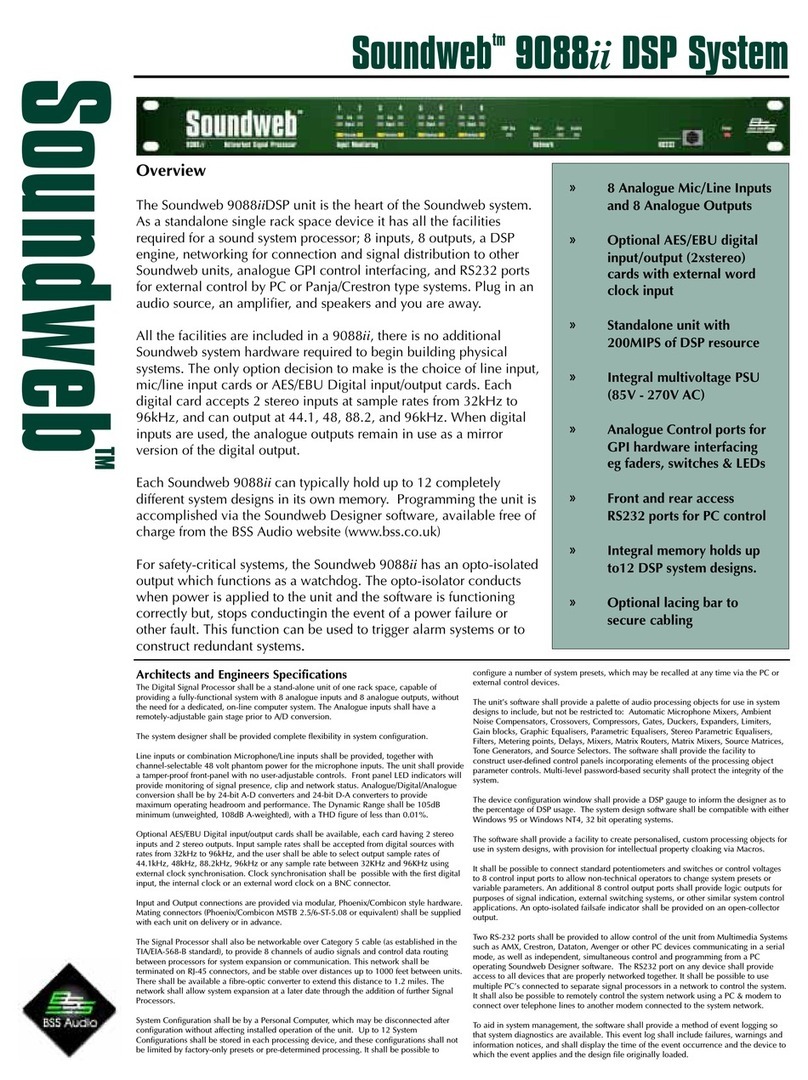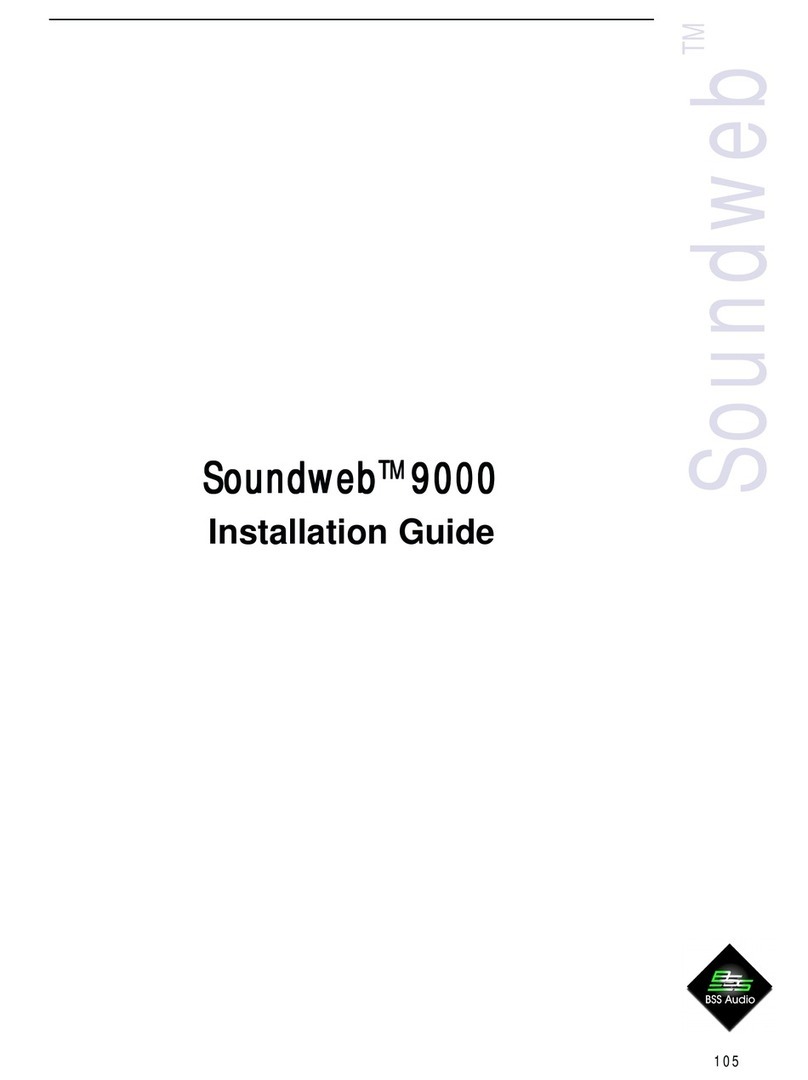
Soundweb™London
Architects & Engineers Specifications
Networked Signal Processors bssaudio.com
The Digital Signal Processor shall be a stand-alone unit of one rack space, capable of providing a fully-functional system with a total of 16 analogue inputs /
analogue outputs configurable by Input Cards and Output Cards in banks of 4, without the need for a dedicated, on-line computer system. The analogue inputs
shall have a remotely-adjustable gain stage prior to A/D conversion.
The system designer shall be provided complete flexibility in system configuration.
Combination Microphone / Line inputs shall be provided, together with channel-selectable 48 volt phantom power per input. The unit shall provide a tamper-proof
front-panel with no user-adjustable controls. Front panel LED indicators will provide monitoring of signal presence, clip and network status. Analogue / Digital
and Digital / Analogue conversion shall be by 24-bit A-D converters and 24-bit D-A converters to provide maximum operating headroom and performance. The
Dynamic Range shall be 105dB minimum (unweighted, 108dB A-weighted), with a THD figure of less than 0.01%.
Input and Output connections are provided via modular, Phoenix / Combicon style hardware. Mating connectors (Phoenix / Combicon MSTB 2.5 / 6-ST-5.08 or
equivalent) shall be supplied with each unit on delivery or in advance.
The Signal Processor shall also be fitted with a Peak Audio CobraNet™ CM-1 card that shall allow the unit to send and receive audio signals to and from other
CobraNet™ devices via a standard Ethernet network over Category 5 cable (as established in the TIA/EIA-568-B standard). This network shall be terminated on
RJ-45 connectors, and be stable over distances up to 100 metres between unit and Ethernet switch. The network shall allow system expansion at a later date through
the addition of further Signal Processors. The CobraNet™ card shall allow a maximum of 4 bundles of 8 channels. 48kHz and 96kHz CobraNet operation shall be
possible. The network also enables routing of control data between processors.
The Signal Processor shall be fitted with a digital audio bus on BLU-800, 320, 160 and 120 devices. The bus shall allow transfer of 256 channels of audio (at 48kHz
sample rate, 128 channels at 96kHz) on a point to point connection between devices using Category 5e cable terminated on RJ-45 connectors and be stable over
distances up to 100 metres between devices. The bus shall also feature redundancy by completing the connection in a ring
System configuration shall be by a Personal Computer, which may be disconnected after configuration without affecting installed operation of the unit. System
configurations shall be stored in each processing device, and these configurations shall not be limited by factory-only presets or pre-determined processing. It shall
be possible to configure a number of system presets, which may be recalled at any time via the PC or external control devices.
A front panel LCD will provide preset recall status and fault reporting. A non-latching switch on both front and rear panel will allow identification of the networked
processor on a host computer. The non-latching switches will be able to be illuminated to allow identification of a processor from the host computer.
The control software shall provide a palette of audio processing objects for use in system designs to include, but not be restricted to: Crossovers, Compressors,
Gates, Duckers, Expanders, Limiters, Gain blocks, Graphic Equalizers, Stereo Graphic Equalizers, Parametric Equalizers, Stereo Parametric Equalizers, Filters,
Metering points, Delays, Mixers, Matrix Routers, Matrix Mixers, Source Matrices, Tone Generators, and Source Selectors. The software shall provide the facility
to construct user-defined control panels incorporating elements of the processing object parameter controls. Multi-level password-based security shall protect the
integrity of the system.
The device configuration window shall provide a DSP gauge to inform the designer as to the percentage of DSP usage. The system design software shall be
compatible with Windows XP Home, Windows XP Professional and Windows 2000 operating systems.
It shall be possible to connect standard potentiometers and switches or control voltages to 12 control input ports enabling non-technical operators to change system
presets or variable parameters. An additional 6 control output ports shall provide logic outputs for purposes of signal indication, external switching systems, or other
similar system control applications. An opto-isolated failsafe indicator shall be provided on an open-collector output.
It shall also be possible to control and design the system network remotely using a PC connected into the system control Ethernet network.
An RS-232 port shall be provided to allow control of the unit from Multimedia Systems such as Crestron, Dataton, Extron, Avenger or other PC devices
communicating in a serial mode. The RS232 port on any device shall provide access to all devices that are properly networked together.
To aid in system management, the software shall provide a method of event logging so that system diagnostics are available. This event log shall include failures,
warnings and information notices, and shall display the time of the event occurrence, the device to which the event applies and the design file originally loaded.
There shall be an additional units available that will be able to expand the input and output capacity of the system. This unit shall be identical in networking
capabilities as the main signal processor, and feature identical input/output card configuration. The unit shall not feature any DSP resources.
There shall be an additional stand-alone units available without Peak Audio CobraNet CM-1 installed. This unit shall be identical in DSP resources as the main
signal processor, and feature identical input/output card configuration. A single RJ-45 Ethernet port is provided for connection to a network for DSP configuration or
control. The device will connect into the Ethernet control network with Category 5 cable.
There shall be available a programmable remote controller device, which shall provide up to 8 programmable buttons on a touchscreen liquid crystal display, a
rotary encoder and page select and navigation switches. The remote control shall offer 100 pages, each protectable with a user definable password. The remote
controller shall connect into the Ethernet control network with Category 5 cable. The remote control shall be capable of being housed in a standard NEMA-style,
3-Gang junction backbox.
There shall be available a programmable remote controller device, which shall provide 2 rotary encoders and programmable buttons. The remote controller shall
connect into the Ethernet control network with Category 5 cable. The remote control shall be capable of being housed in a standard NEMA-style, 3-Gang junction
backbox.
Smaller wall-mounting panels shall be available that allow control of sources and level (or similar functions) by connecting onto the control ports on the digital
signal processor housed in a standard UK light switch wall panel.
The digital signal processor shall be the BSS Audio Soundweb London BLU-80, BLU-800 and BLU-160.
The input/output expansion unit shall be the BSS Audio Soundweb London BLU-32, BLU-320 and BLU-120.
The stand-alone unit shall be the BSS Audio Soundweb London BLU-16.
The programmable touch screen remote controller shall be the BSS Audio Soundweb London BLU-10.
The programmable remote controller shall be the BSS Audio Soundweb London BLU-8.
The wall-mounting panels shall be the BSS Audio Soundweb BLU-3 and BLU-6.
BSS AUDIO | 8760 S. Sandy Parkway | Sandy, UT 84070 U.S.A | Ph. +1 - 801-566-8800 | Fax +1 - 801-566-7662
18-0586























